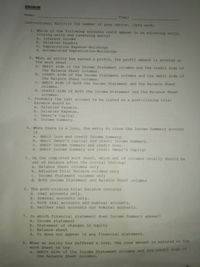
FINANCIAL ACCOUNTING
10th Edition
ISBN: 9781259964947
Author: Libby
Publisher: MCG
expand_more
expand_more
format_list_bulleted
Concept explainers
Question

Transcribed Image Text:ENGAGE
Name:
Time:
Instructions: Encircle the number of your choice. (2pts each)
1. Which of the following accounts could appear in an adjusting entry,
closing entry and reversing entry?
a. Interest Income
b. Salaries Payable
c. Depreciation Expense-Buildings
d. Accumulated Depreciation-Buildings
2. When an entity has earned a profit, the profit amount is entered on
the work sheet
a. debit side of the Income Statement columns and the credit side of
the Balance Sheet columns.
b. credit side of the Income Statement columns and the debit side of
the Balance Sheet columns.
c. debit side of both the Income Statement and the Balance Sheet
columns.
d. credit side of both the Income Statement and the Balance Sheet
columns.
3. Probably the last account to be listed on a post-closing trial
balance would be
a. Salaries Payable.
b. Salaries Expense.
c. Owner's Capital
d. Income Summary.
4. When there is a loss, the entry to close the Income Summary account
is
a. debit Loss and credit Income Summary.
b. debit Owner's Capital and credit Income Summary.
c. debit Income Summary and credit Loss.
d. debit Income Summary and credit Owner's Capital
5. On the completed work sheet, which set of columns usually should be
out of balance after the initial footing?
a. Balance Sheet columns only
b. Adjusted Trial Balance columns only
c. Income Statement columns only
d. Both Income Statement and Balance Sheet columns
6. The post-closing trial balance contains
a. real accounts only.
b. nominal accounts only.
c. both real accounts and nominal accounts.
d. neither real accounts nor nominal accounts.
7. In which financial statement does Income Summary appear?
a. Income statement
b. Statement of changes in equity
c. Balance sheet
d. It does not appear in any financial statement.
8. When an entity has suffered a loss, the loss amount is entered on the
work sheet on the
a. debit side of the Income Statement columns and the credit side ot
the Balance Sheet columns.
Expert Solution
This question has been solved!
Explore an expertly crafted, step-by-step solution for a thorough understanding of key concepts.
This is a popular solution
Trending nowThis is a popular solution!
Step by stepSolved in 2 steps

Knowledge Booster
Learn more about
Need a deep-dive on the concept behind this application? Look no further. Learn more about this topic, accounting and related others by exploring similar questions and additional content below.Similar questions
- A change in depreciation method is a______. Select one: a. change in accounting standard b. change in accounting estimate c. change in accounting method d. change in accounting policyarrow_forwardThe adjusting entry to record depreciation includes a. a debit to an expense account. O b. a debit to a liability account. O c. a credit to stockholders' equity account. O d. a debit to an asset account.arrow_forwardRecording depreciation for a plant asset conforms to which accounting principle/assumption? OA. Matching Principle B. Time Period Assumption OC. Full Disclosure Principle OD. Revenue Recognition Principle***arrow_forward
- Explain an example to record the adjusting entry for accrued revenue.arrow_forwardDescribe the accounting changes in depreciation.arrow_forwardWhich of the following accounts could be part of a regular journal entry, an adjusting entry, a closing entry, and a reversing entry? interest revenue account receivable depreciation expense unearned revenue prepaid insurancearrow_forward
- Accounting Changes A material, prior period error impacting repairs expense.will affect which account(s) in subsequ O current liabilities O current assets O retained earnings operating expense Save for Later 12arrow_forwardOn the balance sheet, accumulated depreciation is: Group of answer choices subtracted from property and equipment. added to total liabilities. added to property and equipment. subtracted from total liabilities.arrow_forwardWhich of the following are all temporary accounts? a.Liabilities and assets b.Liabilities, revenue, and expenses c.Assets, liabilities, and owner's Drawing d.Revenue, expenses, and the Owner's Drawing e.Revenue, liabilities, and the owner's Drawingarrow_forward
- How would accumulated depreciation be classified on the balance sheet? current asset fixed asset current liability O long term liabilityarrow_forwardHow is the account Land classified and what kind of balance should it have? Group of answer choices fixed, credit current asset, debit fixed, debit current asset, creditarrow_forward
arrow_back_ios
arrow_forward_ios
Recommended textbooks for you

 AccountingAccountingISBN:9781337272094Author:WARREN, Carl S., Reeve, James M., Duchac, Jonathan E.Publisher:Cengage Learning,
AccountingAccountingISBN:9781337272094Author:WARREN, Carl S., Reeve, James M., Duchac, Jonathan E.Publisher:Cengage Learning, Accounting Information SystemsAccountingISBN:9781337619202Author:Hall, James A.Publisher:Cengage Learning,
Accounting Information SystemsAccountingISBN:9781337619202Author:Hall, James A.Publisher:Cengage Learning, Horngren's Cost Accounting: A Managerial Emphasis...AccountingISBN:9780134475585Author:Srikant M. Datar, Madhav V. RajanPublisher:PEARSON
Horngren's Cost Accounting: A Managerial Emphasis...AccountingISBN:9780134475585Author:Srikant M. Datar, Madhav V. RajanPublisher:PEARSON Intermediate AccountingAccountingISBN:9781259722660Author:J. David Spiceland, Mark W. Nelson, Wayne M ThomasPublisher:McGraw-Hill Education
Intermediate AccountingAccountingISBN:9781259722660Author:J. David Spiceland, Mark W. Nelson, Wayne M ThomasPublisher:McGraw-Hill Education Financial and Managerial AccountingAccountingISBN:9781259726705Author:John J Wild, Ken W. Shaw, Barbara Chiappetta Fundamental Accounting PrinciplesPublisher:McGraw-Hill Education
Financial and Managerial AccountingAccountingISBN:9781259726705Author:John J Wild, Ken W. Shaw, Barbara Chiappetta Fundamental Accounting PrinciplesPublisher:McGraw-Hill Education


Accounting
Accounting
ISBN:9781337272094
Author:WARREN, Carl S., Reeve, James M., Duchac, Jonathan E.
Publisher:Cengage Learning,

Accounting Information Systems
Accounting
ISBN:9781337619202
Author:Hall, James A.
Publisher:Cengage Learning,

Horngren's Cost Accounting: A Managerial Emphasis...
Accounting
ISBN:9780134475585
Author:Srikant M. Datar, Madhav V. Rajan
Publisher:PEARSON

Intermediate Accounting
Accounting
ISBN:9781259722660
Author:J. David Spiceland, Mark W. Nelson, Wayne M Thomas
Publisher:McGraw-Hill Education

Financial and Managerial Accounting
Accounting
ISBN:9781259726705
Author:John J Wild, Ken W. Shaw, Barbara Chiappetta Fundamental Accounting Principles
Publisher:McGraw-Hill Education